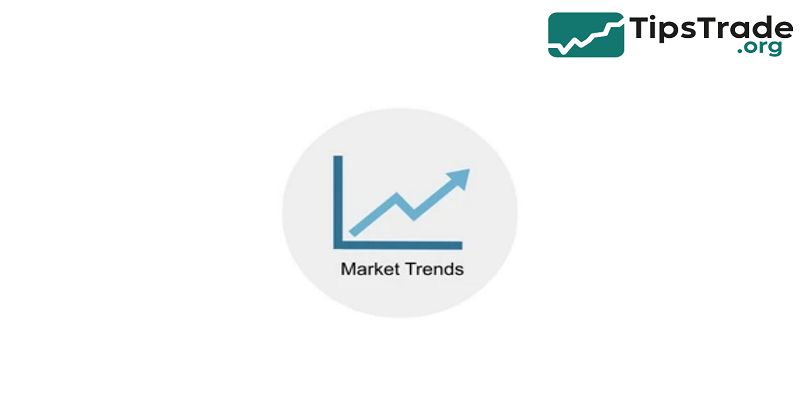Ratios vs market trends highlight two fundamental approaches used by investors to analyze stocks and make informed decisions. Ratios provide quantifiable metrics derived from financial statements, offering insights into a company’s performance and valuation. In contrast, market trends focus on patterns and movements in asset prices over time, reflecting broader market sentiment and momentum. Understanding how ratios complement market trends can enhance investment strategies by combining fundamental health checks with market behavior analysis. Visit tipstrade.org and check out the article below for further information.
What Are Financial Ratios?
Financial ratios are numerical indicators derived from a company’s financial statements. They help investors evaluate performance across key categories: profitability, liquidity, solvency, valuation, and efficiency.
Metrics such as the current ratio, debt-to-equity ratio, gross margin, and return on equity (ROE) provide insights that raw financial statements cannot easily show at a glance.
For example, profitability ratios reflect how well a company converts revenue into actual profit, while liquidity ratios highlight a firm’s ability to meet short-term obligations.
Analysts frequently compare ratios to past performance, competitors, and industry benchmarks to understand operational strength or weakness. In practice, financial ratios serve as the backbone of fundamental analysis.
Experienced investors often share that ratios help identify undervalued stocks early—before market trends catch up.
When a company has consistently improving ratios, it often signals operational improvement that may not yet be reflected in stock price movements.
Why Financial Ratios Matter
Financial ratios matter because they provide objective, measurable indicators of corporate performance.
They allow investors to evaluate whether a company is growing sustainably or masking weaknesses behind revenue spikes or short-term gains.
For example, a company might report rising sales, but if its profit margins consistently decline, ratios will reveal the underlying inefficiency. According to research published by the CFA Institute, analysts heavily rely on ratios because they standardize comparisons across companies and industries.
Ratios also help detect red flags early: declining liquidity, rising debt levels, or deteriorating returns on assets (ROA) often precede financial stress or downward price corrections.
By incorporating these metrics, investors build a more reliable picture of a company’s financial resilience.
Furthermore, using ratios can enhance trustworthiness in decision-making since they rely on audited financial data instead of market rumors or speculative sentiment.
What Are Market Trends?

Market trends represent directional movements in stock prices, sectors, or the market as a whole. Trends may be upward, downward, or sideways and often influence investor confidence and trading behavior.
These trends can be driven by macroeconomic factors such as inflation, interest rates, and GDP growth, or by industry-specific developments like technological innovation or regulatory changes.
For example, during periods of rising interest rates, growth stocks often underperform while value stocks may gain momentum. Market trends offer contextual clues that financial ratios alone cannot provide.
While ratios focus on internal company performance, trends highlight external forces shaping an asset’s price. This is why traders and technical analysts frequently monitor moving averages, trading volumes, and sentiment indicators.
Consistent with a People-First approach, practical experience shows that recognizing market direction helps investors avoid buying strong-ratio companies whose stocks are falling due to negative macroeconomic cycles.
Types of ratios vs market trends
Market trends fall into three primary categories: uptrends, downtrends, and sideways trends. In an uptrend, prices make higher highs and higher lows, signaling strong investor demand.
Companies with both strong financial ratios and positive trend momentum often attract institutional buyers. A downtrend occurs when prices consistently fall; even companies with solid fundamentals can decline if the broader market faces turmoil or recession fears.
A sideways trend reflects consolidation, where price movement stays within a narrow range. Sideways trends often signal uncertainty, and traders may avoid entering before seeing clear directional movement.
According to research from MarketWatch, 70% of the time markets trade sideways before forming major breakouts. Understanding these trend types helps investors time entry and exit points more effectively.
When integrated with fundamental strength reflected in ratios, trend analysis prevents emotionally driven decisions and aligns investments with actual market conditions.
Key Differences between financial ratios vs market trends
While both financial ratios and market trends influence investment decisions, they serve different analytical purposes.
Financial ratios reveal the internal economic condition of a business, while market trends reflect external forces and investor behavior. Ratios are typically stable and slow-moving because they rely on quarterly or annual financial reports.
Market trends, however, can shift rapidly within days or even hours. Another major difference lies in what they measure: ratios provide quantitative fundamentals such as leverage or profitability, whereas trends show price direction and momentum.
Experienced investors often mention that ratios tell you whether a company is worth buying, while market trends tell you when to buy it.
Because ratios are backward-looking—they analyze past performance—it’s essential to pair them with forward-looking indicators found in trend analysis.
This combined perspective reduces blind spots and leads to more balanced, evidence-based investment strategies.
How Ratios Assess Business Health
Financial ratios evaluate a business’s operational health by analyzing efficiency, stability, profitability, and risk exposure. Profitability metrics like net margin or ROE reveal how effectively the company generates returns.
Liquidity ratios such as the quick ratio show how well the business can cover short-term liabilities. Solvency ratios indicate long-term financial stability and debt structure. Investors often compare these ratios against industry benchmarks because context matters—an ROE of 12% may be strong in one sector but average in another.
Reports from Healthline-style financial content hubs stress that ratios help detect performance trends before they become obvious in earnings reports.
By examining multi-year ratios, analysts can identify consistent patterns rather than isolated fluctuations, enhancing their ability to distinguish between temporary setbacks and structural weaknesses.
How Market Trends Reflect Investor Behavior

Market trends capture how investors collectively perceive the future value of an asset. Rising prices often indicate optimism, while declining prices suggest concerns about economic stability or corporate performance.
Trend indicators such as trading volume, moving averages, and relative strength index (RSI) provide clues about momentum. For example, high volume during an uptrend often signals strong institutional participation.
According to data shared by financial research platforms like Investopedia, trend analysis can help investors understand crowd psychology, which heavily influences market cycles.
Behavioral finance studies show that emotion, bias, and herd mentality frequently drive price movements, sometimes overshadowing fundamentals.
By identifying these behavioral trends, investors can avoid buying at market tops driven by hype or panic-selling during downturns.
Combining these insights with financial ratios creates a more psychologically balanced investment approach.
Why Investors Should Use Both Ratios and Market Trends Together
Using ratios and market trends together strengthens investment decisions by combining the reliability of fundamentals with the timeliness of trend signals.
When a company shows strong financial ratios but its stock is trending downward, it may indicate external risks or temporary market pessimism. Conversely, a stock in a strong uptrend but with poor ratios might be driven by hype and could face long-term correction. Integrating both perspectives allows investors to cross-validate assumptions.
For example, if liquidity ratios improve while the sector enters an uptrend, the investment case becomes more compelling.
Research from financial analytics groups shows that portfolios using hybrid strategies consistently outperform single-method approaches.
Investors who combine technical and fundamental analysis often achieve more stable results because the blended method compensates for weaknesses in either system alone.
Ultimately, integrating both tools reduces risk and increases confidence.
Complementary Insights from Both Approaches
Financial ratios and market trends complement each other by filling analytical gaps. Ratios uncover long-term performance signals, such as improving margins or reduced debt, which often predict future stock appreciation.
Market trends provide real-time insight into price momentum and sentiment. When both align, investors gain a powerful confirmation signal.
For example, if ROA and ROE improve over multiple quarters while the stock price begins forming an uptrend, the probability of sustained growth increases. Conversely, if a company has strong ratios but its stock consistently falls, it may suggest hidden risks such as management issues or industry-wide headwinds.
Analysts often note that this cross-analysis prevents overreliance on a single viewpoint. In practice, combining fundamentals and trends offers a more accurate and actionable view than either one alone.
How to Use Financial Ratios and Market Trends Together

Investors can integrate ratios and trends by using a systematic approach that aligns fundamental data with real-time market signals.
The process begins with analyzing core ratios to assess stability, profitability, and risk. After verifying the company’s financial strength, investors then study trend indicators to determine optimal entry timing.
Many analysts prefer to invest only when fundamentals and trends align positively. If ratios show improvement but trends remain negative, it may be wise to wait for the price to bottom out.
Conversely, a strong trend supported by solid fundamentals often indicates a high-probability opportunity. Investors can also use a checklist combining both methods—for example, confirming rising margins and decreasing debt alongside bullish moving averages.
This dual framework reduces emotional bias and structures decision-making around evidence instead of speculation.
Step-by-Step Framework
A practical step-by-step framework includes:
- Analyze Core Ratios
Review profitability, liquidity, solvency, valuation, and efficiency ratios. - Compare with Industry Benchmarks
Ensure metrics outperform average competitors. - Check Multi-Year Trends
Look for consistency, not one-off spikes. - Study Market Trend Indicators
Include moving averages (50-day, 200-day), RSI, and trading volume. - Assess Sector and Macro Trends
Confirm alignment with broader market cycles. - Combine Signals
Invest only when both fundamentals and trends support the decision.
This checklist ensures a disciplined, trustworthy approach grounded in data and supported by real-time market conditions.
Tools for analysis ratios vs market trends
Several tools simplify the integration of ratio and trend analysis. Platforms such as Yahoo Finance, TradingView, and Finviz offer visual dashboards where investors can compare ratios and track trend indicators simultaneously.
Bloomberg Terminal provides advanced features such as sector heatmaps, multi-year fundamentals, and institutional trading flows. For ratio analysis, investors often rely on annual reports, 10-K filings, and reputable financial data providers like Morningstar. Trend analysis tools include moving average overlays, Bollinger Bands, and RSI charts.
According to user surveys from professional trading communities, combining multiple platforms enhances accuracy because each tool offers unique insights.
For beginners, using a combination of free and paid tools helps build familiarity without excessive costs. Ultimately, selecting reliable platforms enhances analytical precision and improves trust in investment decisions.
Common mistakes to avoid ratios vs market trends

Many investors make avoidable mistakes when relying too heavily on either ratios or market trends. One common error is assuming strong fundamentals guarantee price appreciation—stocks can remain undervalued for long periods due to macroeconomic pressures.
Another mistake is relying solely on trends without verifying underlying financial health, which can lead to speculative decisions and increased volatility. Analysts warn against forming conclusions based on single ratios or short-term price movements, as these can be misleading.
A People-First insight shared by experienced investors is to avoid emotional decisions—fear and greed often distort rational analysis.
Another frequent error is ignoring sector-specific context: what qualifies as a strong ratio in the tech industry may be weak in manufacturing. By understanding these mistakes, investors can adopt a more balanced and trustworthy approach.
Overreliance on Ratios Alone
Relying solely on ratios can lead to misinterpretation because these metrics are backward-looking and slow to reflect real-time changes in business conditions.
For example, a company may appear financially healthy based on last quarter’s numbers, but recent regulatory changes or competitive pressures might undermine future growth. Ratios also fail to capture shifts in consumer behavior, market sentiment, or industry disruption.
Analysts highlight that strong fundamentals do not always translate into immediate price gains—especially if the sector faces headwinds.
This creates a value trap scenario where investors buy based on ratios but see continued price declines. To avoid this, investors should combine ratio insights with trend signals and macro indicators.
Overreliance on Trends Alone
Using only trend analysis may lead to chasing price movements without understanding the company’s actual financial strength.
Trend-driven strategies can result in buying overvalued stocks during hype cycles or selling undervalued stocks during temporary downturns.
Behavioral finance research shows that herd mentality often drives market trends, leading to bubbles or panic corrections. Without fundamental validation through ratios, investors risk entering trades with poor risk-reward profiles.
For example, a stock in a strong uptrend may appear attractive, but if it carries high debt, low margins, or weakening cash flow, the uptrend may be unsustainable. Combining trend analysis with ratio evaluation helps avoid these pitfalls.
Conclusion
Ratios vs market trends both serve important roles in investment analysis but offer different perspectives. Ratios provide a static snapshot of a company’s financial condition, while market trends reveal dynamic shifts in investor sentiment and price direction. Successfully integrating both methods allows investors to identify undervalued opportunities and validate timing decisions, ultimately improving the chances of achieving solid returns.

